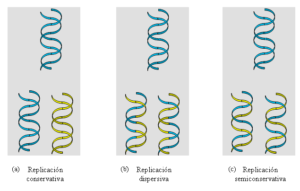12 Alternative Facts of Human Genetics
I’ve always wanted to write about my favorite experiment in human genetics, but a news hook was elusive. Not any more! Thank you Kellyanne Conway for your intriguing concept of “alternative facts.”
I’m writing the 12th edition of my human genetics textbook right now, so it’s the perfect time to browse through the pages and select a few turning points in time when genetic reality might have diverged, leading to different outcomes, if “alternative facts” were possible. But first, to illustrate how scientists reject hypotheses to reach a conclusion, a brief review of what’s been called “The Most Beautiful Experiment in Biology.”
REVEALING THE MECHANISM OF DNA REPLICATION
When Watson and Crick deduced the double helical structure of DNA in 1953, they ended their famous paper with a statement that catalyzed a decade of experiments: “It has not escaped our notice that the specific pairing we have postulated immediately suggests a possible copying mechanism for the genetic material.”
 In 1958, two young researchers at CalTech, Matthew Meselson and Franklin Stahl, hypothesized 3 ways for one double helix to become two. A double helix:
In 1958, two young researchers at CalTech, Matthew Meselson and Franklin Stahl, hypothesized 3 ways for one double helix to become two. A double helix:
• unzips and each side builds a new partner from available nucleotide building blocks (semi-conservative replication)
• directs formation of a second double helix (conservative replication)
• shatters into pieces that join with free nucleotides to build mosaic new helices (dispersive replication)
To distinguish among the hypotheses, Meselson and Stahl labeled replicating DNA in bacteria with a heavy isotope of nitrogen. The resulting visible patterns of “heavy” versus “light” daughter DNA molecules revealed replication as semi-conservative, and at the same time, neither conservative nor dispersive. Many further experiments by others confirmed this singular reality in different species. DNA doesn’t veer among the 3 mechanisms; only one is correct. Cleverly demonstrated, elegant, logical science.
WHAT IF???
It’s fun to imagine alternative facts/realities of genetics. Here are a dozen, in no particular order.
• Protein might be the genetic material and DNA not. Or both! (See Griffith and Avery, MacLeod, and McCarty).
• DNA might be a triple helix, as Linus Pauling hypothesized (it made sense until experiments and logic showed otherwise).
• The most likely first molecule of life might have been a lipid, and not RNA. We’d be biochemically based on fat.
• Humanity might have originated in the Bronx, not Africa, 6 days after the earth formed.
 • Humans and chimps might not have diverged from a shared ancestor 5 million years ago, nor the ancestors of both from orangutans 8 million years ago. (See Bill Maher).
• Humans and chimps might not have diverged from a shared ancestor 5 million years ago, nor the ancestors of both from orangutans 8 million years ago. (See Bill Maher).
• Shared DNA sequences might not reflect ancestry, just incredible coincidence.
• AIDS might be caused by amyl nitrate poppers, autism by vaccines, and breast cancer by abortions.
• Human genomes might have 100,000 genes as originally hypothesized, not the 20,000 or so that experiments eventually revealed.
• Mendel’s peas distributed themselves as they did for the 7 traits he studied not because genes on different chromosomes assort independently, but because they were seeking partners for a square dance. (See Mendel)
 • A sperm cell might contain a tiny human, rather than a genome’s worth of DNA and not much else.
• A sperm cell might contain a tiny human, rather than a genome’s worth of DNA and not much else.
• The several species of australopithecines might have remained separate, leading to several species of modern humans.
• The human chromosome number might be 48, not 46. The original count of 48 was based on sketches of testis cells from patients at a Texas state mental hospital, castrated to treat their aggressive behavior, done in 1923. (See Theophilus Painter) The men might have had abnormal chromosome numbers.
Anyone care to add to the list? Or broaden it beyond genetics? What great fun to redo all of science to open up possibilities of how things are in the natural world.
THREATS TO SCIENCE AND SCIENTISTS RIGHT NOW
One stark difference between the scientific method’s using evidence to narrow down possibilities (disproving hypotheses) and the new mantra of alternative facts is that scientific inquiry is not judgmental nor does it have an agenda. Knowingly and repeatedly stating a different and distorted view of reality, in the face of abundant evidence to the contrary (photos and eyewitness accounts of inauguration attendance, for example) is called lying.
If the new administration in the U.S. doesn’t even have a glimmer of how science is actually done, operating in a bizarre universe of constantly changing multiple truths, then rational discussion on such matters as climate change, vaccines, and human reproduction is simply no longer possible. But silencing scientists at federal agencies from communicating with the public, such as through the news releases from such agencies as the NIH, EPA, and USDA that we science journalists depend on, is a step that is frighteningly Orwellian.
 Scientists and those who love science are organizing. Now. Check out the info on the March for Science, which emerged from the primordial ooze to which we are rapidly regressing in the wake of the temporary take-down of media pages at federal agencies. To bend the words of Data from Star Trek:Next Generation into an alternate fact, let’s hope resistance is NOT futile.
Scientists and those who love science are organizing. Now. Check out the info on the March for Science, which emerged from the primordial ooze to which we are rapidly regressing in the wake of the temporary take-down of media pages at federal agencies. To bend the words of Data from Star Trek:Next Generation into an alternate fact, let’s hope resistance is NOT futile.



[…] Source: 12 Alternative Facts of Human Genetics […]
[…] Source: PLOS EveryONE […]